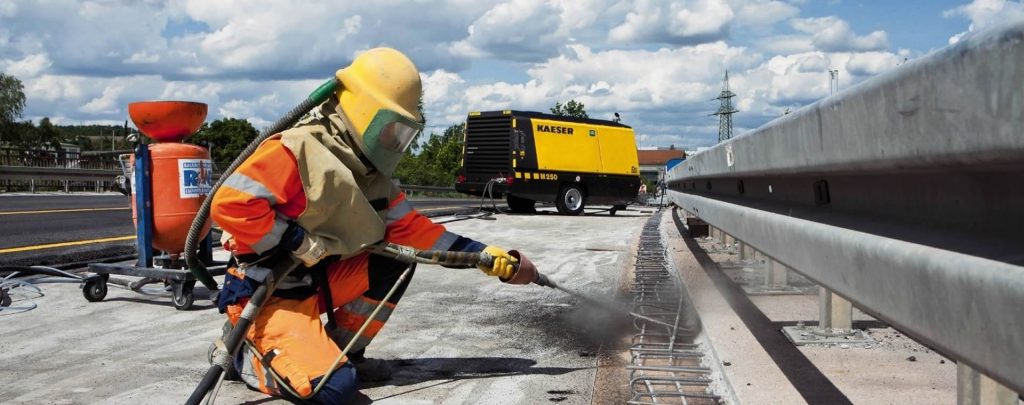Guide to Sandblasting: Techniques, Applications, and Safety Measures
Sandblasting, also known as abrasive blasting, is a powerful and versatile technique used in various industries to clean, smooth, or shape surfaces. This method involves propelling abrasive materials against a surface at high speed to remove contaminants, rust, paint, and other unwanted substances. In this blog, we’ll delve into the details of sandblasting, including its techniques, applications, safety measures, and benefits.
Introduction to Sandblasting
Sandblasting is a process that uses compressed air to blast a surface with abrasive materials, effectively cleaning or etching it. The technique was developed in the late 19th century and has since evolved to include various methods and materials, making it an essential tool in numerous industries. The primary goal of sandblasting is to prepare surfaces for painting, coating, or further treatment, ensuring a clean and smooth finish.
Techniques of Sandblasting
Sandblasting techniques have diversified over the years, each with its specific applications and benefits. Here, we explore the most common techniques used today.
Traditional Sandblasting
Traditional sandblasting involves using silica sand as the abrasive material. The sand is propelled at high velocity by compressed air through a nozzle. This method is effective for removing rust, paint, and other contaminants from metal surfaces. However, due to health concerns related to silica dust inhalation, this method has been largely replaced by safer alternatives.
Wet Sandblasting
Wet sandblasting combines abrasive materials with water, reducing dust and minimizing health risks. This technique is ideal for cleaning surfaces that require a more delicate touch, such as wood or softer metals. The water acts as a cushion, reducing the impact force of the abrasive particles and preventing damage to the surface being treated.
Vapour Blasting
Vapour blasting, also known as slurry blasting, mixes water, abrasive media, and compressed air to create a fine mist. This method is particularly effective for achieving a smooth finish on delicate surfaces like aluminium or magnesium. Vapor blasting is often used in the automotive and aerospace industries for cleaning and polishing engine components.
Applications of Sandblasting
Sandblasting is a versatile technique used in a wide range of applications, from heavy industrial processes to intricate artistic creations. Here are some of the most common uses of sandblasting.
Industrial Uses
In industrial settings, sandblasting is primarily used for surface preparation. This includes removing rust, scale, and old paint from machinery, pipelines, and storage tanks. By providing a clean and roughened surface, sandblasting ensures better adhesion for new coatings and paints, prolonging the lifespan of industrial equipment.
Automotive Industry
The automotive industry relies heavily on sandblasting for both restoration and maintenance. It is used to remove old paint and rust from car bodies, frames, and engine parts. Sandblasting also helps in cleaning parts like cylinder heads, manifolds, and pistons, ensuring optimal performance and longevity of the vehicle.
Construction and Renovation
In construction and renovation, sandblasting is used to clean and prepare surfaces like brick, concrete, and wood. It can remove graffiti, stains, and old paint, restoring the original appearance of buildings and structures. Additionally, sandblasting can be used to create textured finishes on concrete surfaces, enhancing their aesthetic appeal.
Art and Design
Sandblasting is also employed in the art and design world for etching and engraving. Artists use sandblasting to create intricate designs on glass, metal, and stone. This technique allows for precise and detailed work, making it a popular choice for custom signage, decorative panels, and personalized gifts.
Safety Measures in Sandblasting
While sandblasting is highly effective, it also poses significant safety risks if not properly managed. Here are some essential safety measures to consider:
- Protective Gear: Operators should wear appropriate protective gear, including respirators, gloves, and eye protection, to prevent inhalation of dust and contact with abrasive materials.
- Ventilation: Adequate ventilation is crucial in sandblasting operations to disperse dust and reduce the risk of respiratory issues.
- Dust Collection Systems: Using dust collection systems can help capture airborne particles, maintaining a cleaner and safer work environment.
- Training: Proper training for operators is essential to ensure they understand the risks and know how to use equipment safely.
- Regular Maintenance: Keeping sandblasting equipment in good working condition is vital to prevent accidents and ensure efficient operation.
Benefits of Sandblasting
Sandblasting offers numerous benefits, making it a preferred method in various industries:
- Efficiency: Sandblasting quickly removes contaminants and prepares surfaces, saving time compared to manual methods.
- Versatility: It can be used on a wide range of materials, including metal, wood, concrete, and glass.
- Quality Finish: Sandblasting provides a smooth and clean surface, ensuring better adhesion for paints and coatings.
- Cost-Effective: By extending the lifespan of equipment and structures through proper surface preparation, sandblasting reduces maintenance and replacement costs.
Conclusion
Sandblasting is a powerful and versatile technique that plays a crucial
role in many industries. From heavy-duty industrial applications to delicate
artistic projects, it offers an efficient and effective solution for surface
preparation and cleaning. However, it is essential to prioritize safety and
proper training to mitigate the risks associated with sandblasting. By
understanding the various techniques, applications, and safety measures, one
can fully leverage the benefits of sandblasting while maintaining a safe work
environment.

